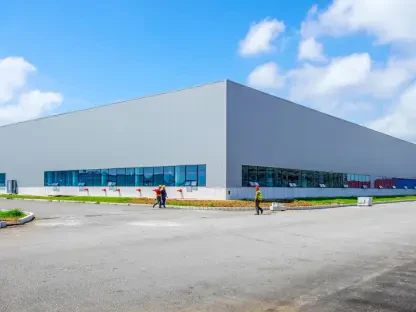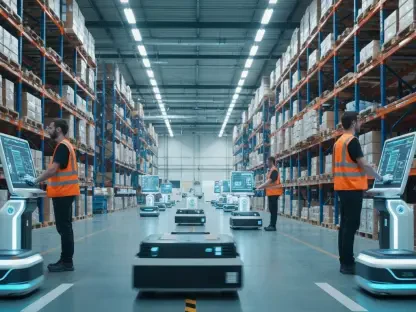Setting the Stage for a Logistics Revolution
Picture a logistics landscape where warehouses operate with clockwork precision, untouched by human hands, as robots and algorithms handle every task from inventory to delivery. In 2025, this vision is not a distant fantasy but a driving force reshaping the global supply chain, fueled by labor shortages and soaring consumer demand for rapid, accurate fulfillment. With the push for autonomous warehouses becoming a critical market focus, this analysis delves into the trends, data, and projections surrounding full automation in warehousing, uncovering how this technology is transforming operations and what it means for industry players. By examining current adoption patterns and forecasting future shifts, the goal is to provide clarity on whether businesses are positioned to capitalize on this seismic change.
Market Dynamics: Tracking the Surge in Warehouse Automation
Adoption Rates and Key Drivers
The warehouse automation market is experiencing unprecedented growth, fueled by persistent labor challenges and the need for operational resilience. Recent industry data indicates that over 64% of logistics companies have already invested in automation technologies this year, with a significant focus on robotics and integrated software systems. The primary driver remains the e-commerce sector, where giants like Royal Mail have achieved 90% automation in parcel processing, setting a benchmark for efficiency. Additionally, sectors such as grocery and retail in regions like the U.K. are accelerating adoption to meet tight delivery windows, pushing the market toward broader implementation. This trend reflects a strategic pivot to mitigate risks associated with workforce variability and rising operational costs.
Technological Pillars Supporting Growth
Central to this market surge are advancements in robotics and software integration, forming the backbone of autonomous warehousing. Hardware solutions, including autonomous mobile robots (AMRs) and automated guided vehicles (AGVs), are streamlining material handling, while companies like Daifuku Co. and Swisslog lead with high-speed shuttle systems and scalable AutoStore setups. Software, such as warehouse execution systems (WES) and enterprise resource planning (ERP) platforms, acts as the orchestrating force, optimizing workflows in real time. Market leaders like Dematic and Honeywell Intelligrated are enhancing these systems with predictive analytics, enabling warehouses to anticipate bottlenecks during peak demand. This fusion of hardware and software is creating a robust ecosystem, though high initial costs remain a barrier for smaller players.
Regional and Sectoral Variations
Divergence in adoption is evident across regions and industries, shaped by unique operational needs and economic factors. In the U.K., e-commerce and grocery sectors prioritize automation to manage stringent cut-off times, with companies like Marks & Spencer expanding automated distribution hubs. Conversely, in emerging markets, adoption lags due to infrastructure constraints and budget limitations, though interest in modular solutions is growing. Sectorally, healthcare and retail lead in implementing goods-to-person systems from providers like KNAPP AG, focusing on precision and error reduction. These variations highlight a fragmented market where tailored strategies are essential, as one-size-fits-all approaches fail to address localized pain points.
Data Deep Dive: Investment Patterns and Performance Metrics
Capital Flow into Automation Technologies
Investment in warehouse automation is a clear indicator of market confidence, with substantial capital directed toward integrated solutions. Surveys from this year reveal that 55% of logistics firms are allocating budgets to forklifts and lift trucks, while 36% target storage equipment and 32% focus on information systems like WMS and ERP. This diversified spending underscores a holistic approach to automation, balancing physical infrastructure with digital oversight. Notably, partnerships with firms like Arnold Machinery and Fortna are on the rise, as businesses seek end-to-end providers to streamline implementation. The financial commitment reflects a long-term bet on automation as a competitive differentiator.
Quantifiable Gains and ROI Benchmarks
Performance metrics paint a compelling picture of automation’s impact on warehouse operations. Case studies, such as Asda’s deployment of an AutoStore system, demonstrate a doubling of picking rates without operational downtime during rollout. Metrics like units per hour (UPH) and order cycle time are improving industry-wide, with automated facilities reporting up to 30% reductions in lead times due to optimized handoffs between storage and packing. Safety statistics also bolster the case, with automated traffic management systems cutting workplace incidents in high-traffic zones, addressing concerns highlighted by Great Britain’s report of 604,000 nonfatal injuries in recent years. These tangible returns are driving further investment, as ROI becomes measurable within shorter timeframes.
Market Challenges: Cost and Integration Hurdles
Despite the momentum, significant challenges temper the market’s growth trajectory. Upfront costs for robotics and software integration remain prohibitive for mid-sized firms, often requiring phased rollouts to manage budgets. Data silos pose another hurdle, as mismatched WMS and ERP systems can disrupt workflows, leading to delays rather than efficiencies. Additionally, the need for robust network infrastructure to support real-time data flow is a persistent issue, particularly for older facilities. Market players must navigate these obstacles by prioritizing scalable solutions and fostering vendor partnerships that offer flexible financing and technical support.
Future Projections: What Lies Ahead for Autonomous Warehousing
Emerging Technologies Shaping the Horizon
Looking toward the coming years, artificial intelligence (AI) and deeper system integration are poised to redefine warehouse automation. AI applications, such as computer vision and predictive analytics, are already enhancing real-time task allocation in U.K. grocery and parcel operations, minimizing operational exceptions. Integration between WES, ERP, and transport management systems is also advancing, smoothing yard and dock operations for national networks. These technologies promise to elevate warehouses into smarter, more connected hubs, with projections suggesting a near-doubling of AI-driven implementations by 2027. The market is clearly trending toward a future where adaptability and intelligence are non-negotiable.
Regulatory and Economic Influences
External factors, including regulatory frameworks and economic pressures, will shape the pace of automation adoption. Stricter data privacy laws and workplace safety mandates are influencing system designs, compelling providers to embed encrypted networks and safety protocols as standard features. Economic uncertainty, while a concern, is paradoxically driving investment as firms seek to insulate against labor cost volatility. Industry forecasts indicate that from 2025 to 2027, regulatory compliance costs may rise by 15%, yet this is unlikely to deter automation spending given the long-term savings on labor and error reduction. Businesses must stay agile to align with these evolving standards.
Competitive Landscape and Market Positioning
The competitive arena for automation providers is intensifying, with firms like Swisslog and Fortna differentiating through service uptime and modular designs. Market positioning hinges on offering tailored solutions—whether high-speed sorters for peak seasons or compact grids for smaller footprints. As larger players dominate high-volume sectors, niche providers are carving out space by addressing specific pain points, such as healthcare’s need for precision picking. This fragmentation suggests a market ripe for consolidation, where strategic alliances and acquisitions could redefine leadership over the next few years. Staying competitive will require a focus on customer-centric innovation and robust after-sales support.
Reflecting on the Automation Journey
Looking back, the journey of autonomous warehousing in 2025 revealed a market at a transformative crossroads, where technology and necessity converged to drive unprecedented adoption. The data underscored remarkable gains in throughput and safety, while challenges like cost and integration highlighted the need for strategic planning. For industry stakeholders, the path forward involved actionable steps: initiating targeted pilots to address specific bottlenecks, selecting partners for comprehensive support, and designing systems with scalability in mind. Beyond immediate gains, the focus shifted to building resilience through AI and deeper integrations, ensuring warehouses could adapt to future demands. This era of automation proved that measured, data-driven steps paved the way for lasting operational strength.









